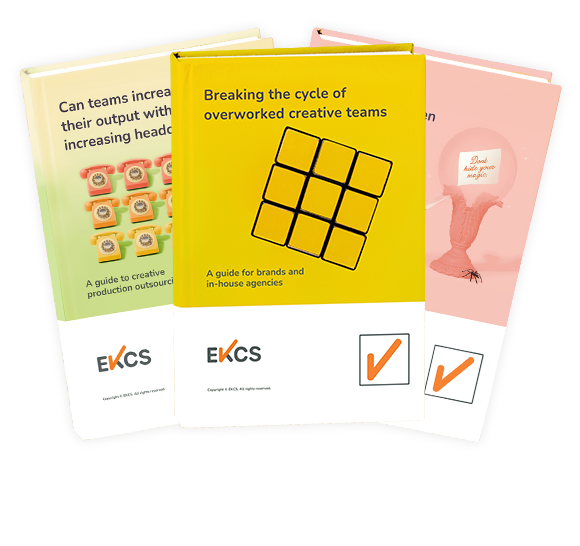
Table of Contents
Share this blog
The Hybrid Approach - Outsourcing while Insourcing
The COVID-19 pandemic saw a rise in the demand to produce more communications, marketing content and digital work at a faster pace. With the spiraling channels available to marketers, it is not surprising that workloads continue to increase and in-house agency (IHA) staff often speak about being overworked!
Even prior to the pandemic, to combat the problem of increasing volumes of work, IHAs were expanding their teams virtually by partnering with external agencies and third-party providers. In 2018, the 2018 IHAF State-of-The-Industry Report reported that 67% of respondents believed that their in-house agency wasn’t adequately staffed.
A 2020 report ‘State of the Market for Offshore Creative Production’ by TKM Consultants showed that 86% of agencies have been offshoring for at least two years. The speed of adoption of companies who are looking to bring on offshore partners has continued to accelerate in the past 12 months.
In a global economy, based on virtual working and digital advertising, access to flexible resources has become a crucial component for any studio manager, looking to fulfill customer requirements in a timely way. A reliable outsourcing partner can deliver a quality service round the clock.
What’s driving in-house agencies to outsource?
Despite the success of the IHA model, additional pressures and quick turnarounds mean that IHAs often use external partners to help. This can be anything from campaign production to programmatic digital advertising or printing.
What is the Hybrid Approach?
The ‘hybrid approach’ is a relatively new strategy discovered and implemented by global brands. Nowadays, the existence of external agencies, or offshore creative production teams, plays a crucial role for IHAs. Their expertise lies in execution at scale according to the latest creative industry standards.
In today’s marketing landscape, collaboration between internal and external agencies is vital. It allows both parties to leverage each other’s strengths and deliver better ROI to the business.
For brands, the in-house strategy remains appealing, but the real value comes when it is combined with the significant offshore savings for production and access to scale. This hybrid model is where the market is undeniably moving, and for good reason too.
The hybrid approach also comes into play during peak periods as it is here that IHAs can leverage the help of external partners. With knowledge transfer and collaboration, external and in-house teams can work in tandem to handle peaks. It further helps the brand to scale marketing production when needed.
The Importance of Keeping Creative in-house
A recent EKCS poll conducted in April 2021 showed that one-fifth of IHA leaders still felt that they were mainly a production entity, running as a centralized production team over and above being creative-led. IHAs consist of talented individuals and therefore they should always be leading creative strategy. A real value of an IHA is bringing creativity close to the brand and selective outsourcing works in the best interest of the brands and their IHAs.
Deciding what projects to outsource is always easier said than done and when it comes to the hybrid approach you should ask yourself:
- What production work can be outsourced to generate more value for the business
- What can be outsourced to free-up time for the in-house team?
- As an IHA what do you do best?
- Some internal creative agencies do all the strategic planning and ideation of a campaign and outsource the execution work, which requires a special skill set.
Benefits of external collaboration
The cost issue looms large now, as Marketing Directors and CMOs are under pressure to prove the ROI on their efforts, something that hiring additional freelancers of extra staff makes it difficult to achieve. An article published by Campaign Live in 2019 highlighted how Nestle was able to reduce production costs by as much as 80% using offshore production partners. Cost savings are a main benefit of outsourcing production work, but there are plenty of other benefits too:
- The time zone advantage - Using off-shore partners working in different time zones can work as an advantage for a creative team when advertising campaigns are to be produced and delivered under tight deadlines.
- Gain better control - By outsourcing the production support to an external agency, you don’t just cut down substantial costs of ramping up a team but also gain control and flexibility.
- Tap into additional skills - Access a bigger pool of talent with an offshore team who have the experience of working with different clients and understands production trends.
- Free up time - Outsourcing production can free up time, and help IHAs to achieve their campaign deadlines. In-house teams can focus on creative tasks and meet other business demands.
The hybrid approach empowers brands
In today’s marketing landscape, collaboration between internal and external agencies is vital. It allows both the parties to leverage each other’s strengths and deliver better ROI. With cost, efficiency and speed more important than before, the hybrid approach can deliver just that.
Since 2008, EKCS has worked with IHAs to provide end-to-end creative production services across digital, video, print and packaging for brands, leaving IHAs to do what they do best – being creative. Contact us to find out more.

To find out more about outsourcing and explore how it can help your team to solve production challenges
Download our FREE GUIDES. They look at the benefits of creative production outsourcing, what to consider in a production partner, and tips on how to get started with outsourcing.
Similar Blogs

The outsourcing dilemma - which projects stay and go?

How to do more for less by outsourcing

To outsource, or not to outsource - that is the question!
Subscribe to our Newsletter
Let's stay in touch! so that we reach out to you with our best news and other insightful content.
